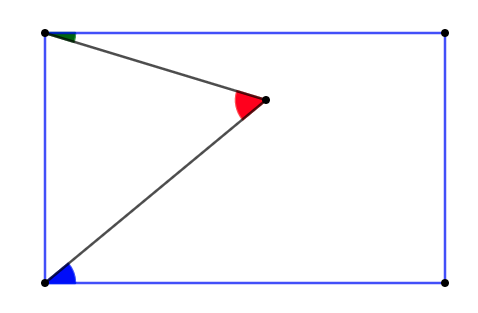Skip over navigation
This problem provides an opportunity for students to practise measuring angles and review their knowledge of angle relationships in a context which leads to a surprising result. We hope that they will be curious about the unexpected outcome and wish to explore and explain why it happens.
"Draw a rectangle and pick a point somewhere inside the rectangle."
It may be helpful to use squared paper to support students in drawing their chosen rectangle.
"Now join your point to the top left and bottom left corners of your rectangle to create a triangle. It might look something like this."
You could show the picture below or this interactive.

"Measure the angles shown in the diagram and keep a record of your results."
You might like to collect the class results in a table:
"What do you notice about these angles?"
There are plenty of things that could be noticed.
Is the red angle always the largest?
What is the largest value the red angle could have?
Is there a relationship between all the three angles?
You might like to add a new column titled Blue Angle + Green Angle as a prompt if this idea doesn't come up as a noticing.
"It looks like the green angle and blue angle add together to give the red angle.
Is this always true?"
"Can we find a way to prove this conjecture?
Can we prove it in more than one way?"
You may find that due to inaccurate measuring that it is not always exactly the case. This may be a useful time to discuss the limitations of the tools we are using.
What do you notice about all the examples?
Is your conjecture always true?
Can you prove it?
Can you prove it in more than one way?
What happens if you start with a parallelogram?
Or a trapezium?
What if the point goes outside the rectangle?
To support students who are not familiar with relationships between angles in different contexts you might invite them to explore the relationships between the angles in this diagram.


Or search by topic
Number and algebra
Geometry and measure
Probability and statistics
Working mathematically
Advanced mathematics
For younger learners
Angles Inside
Age 11 to 14
Challenge Level 





- Problem
- Getting Started
- Student Solutions
- Teachers' Resources
Why do this problem?
This problem provides an opportunity for students to practise measuring angles and review their knowledge of angle relationships in a context which leads to a surprising result. We hope that they will be curious about the unexpected outcome and wish to explore and explain why it happens.
Possible approach
"Draw a rectangle and pick a point somewhere inside the rectangle."
It may be helpful to use squared paper to support students in drawing their chosen rectangle.
"Now join your point to the top left and bottom left corners of your rectangle to create a triangle. It might look something like this."
You could show the picture below or this interactive.

"Measure the angles shown in the diagram and keep a record of your results."
You might like to collect the class results in a table:
| Blue Angle | Green Angle | Red Angle | |
|---|---|---|---|
| 1 | |||
| 2 | |||
| 3 |
"What do you notice about these angles?"
There are plenty of things that could be noticed.
Is the red angle always the largest?
What is the largest value the red angle could have?
Is there a relationship between all the three angles?
You might like to add a new column titled Blue Angle + Green Angle as a prompt if this idea doesn't come up as a noticing.
"It looks like the green angle and blue angle add together to give the red angle.
Is this always true?"
"Can we find a way to prove this conjecture?
Can we prove it in more than one way?"
You may find that due to inaccurate measuring that it is not always exactly the case. This may be a useful time to discuss the limitations of the tools we are using.
Key questions
What do you notice about all the examples?
Is your conjecture always true?
Can you prove it?
Can you prove it in more than one way?
Possible extension
What happens if you start with a parallelogram?
Or a trapezium?
What if the point goes outside the rectangle?
Possible support
To support students who are not familiar with relationships between angles in different contexts you might invite them to explore the relationships between the angles in this diagram.
You may also like
Arclets Explained
This article gives an wonderful insight into students working on the Arclets problem that first appeared in the Sept 2002 edition of the NRICH website.
Bow Tie
Show how this pentagonal tile can be used to tile the plane and describe the transformations which map this pentagon to its images in the tiling.

